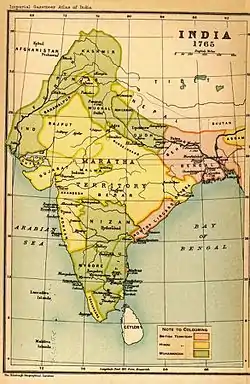Kingdom of Rohilkhand
The Kingdom of Rohilkhand was a powerful Indian State, nominally under Mughal Suzerainty, that arose under the declining Mughal Empire in 1721 and continued to exist until 1774 when annexation by the British transformed its significantly reduced borders into the Princely State of Rampur. Nawab Ali Mohammed Khan, a scion of the ancient Barha Dynasty became the first Nawab of Rohilkhand, having been previously elected as overlord by various Afghan Chiefs at the age of fourteen . He would carve out the future kingdom from the collapsing Mughal Empire and go on to the found the Rohilla Dynasty . The crown would go on being held by the Rohillas until the kingdom came to an end in 1774, and thereafter the same dynasty would rule over Rampur.
Kingdom of Rohilkhand Katehir | |||||||||
|---|---|---|---|---|---|---|---|---|---|
| 1721–1774 | |||||||||
 Flag of the Rohilla | |||||||||
 Rohilkhand Territory in 1765. | |||||||||
| Capital | Aonla | ||||||||
| Common languages |
| ||||||||
| Religion | Islam | ||||||||
| Government | Absolute Monarchy | ||||||||
| Nawab | |||||||||
• 1737-1748 | Ali Mohammed Khan | ||||||||
• 1748-1754 | Abdullah Khan | ||||||||
• 1754-1764 | Saadullah Khan of Rohilkhand | ||||||||
• 1764-1774 | Faizullah Khan | ||||||||
| Regent of Rohilkhand | |||||||||
• 1748-1774 | Hafiz Rehmat Khan Barech | ||||||||
| Legislature | Rohilla Council | ||||||||
| History | |||||||||
• Conquests of Aonla and Barha by Ali Mohammed Khan | 1721 | ||||||||
| 1774 | |||||||||
| Area | |||||||||
| 1774 | 31,080 km2 (12,000 sq mi) | ||||||||
| Population | |||||||||
• 1748 | 6,000,000 | ||||||||
| |||||||||
Most of Rohilkhand's borders were established by Ali Mohammed Khan and largely came into existence as a check to the power of Oudh State and in that capacity, Nawab Ali Mohammed was supported by the Wazir al Mulk, Qamarudin Khan. Nonetheless, the state grew far more influential with its borders extending to the boundaries of Delhi and Agra. Expanding into United Punjab, much of Uttar Pardesh, and temporarily into Uttarakhand, the Kingdom would encompass the Indian Emperors gaining near virtual control over the Empire and direct control over most of North-Western India. It was annexed at the close of the First Rohilla War when the mismanagement of Hafiz Rehmat Khan along with the internal division of the Rohilla Confederation led to the weakening of central authority.
Etymology
The ancient name for Rohilkhand was Katehir. The name Rohilkhand was applied in the middle of the eighteenth century when it fell into the hands of the Rohilla Dynasty started by Nawab Ali Mohammad Khan Bahadur Rohilla. Although the term rohilla was previously used by Afghans who arrived in India.[1]
Geography
Located on the Eastern side of the Ganges, Rohilkhand lies over much of the plain that eventually leads to Oudh. There is no natural barrier between Oudh and Rohilkhand and both share a damp climate due to their locality next to the Himalayan Mountain range. Both also have more luxuriant vegetation than the surrounding areas, and were much known for the greater abundance of wood. The visibility of the snowy Himalayan Mountain tops gave an overall pleasant aspect to the territory.
Immediately below the mountains, there was a forest consisting of sand and boulders without any river running through it but instead the water would be absorbed and would appear about 10–12 miles later towards the end of the forest. This forest of Bhabar, no longer exists in present times but previously it led up to a swamp where the water would reappear at the surface. This swamp with its tall reeds was famous for its Tigers as well as its seasonal fevers. It was known as Tarai and crucially it formed a place of refuge for the people of Rohilkhand during times of invasion. Tarai extends for a breadth of 10 miles and during the era of the Kingdom of Rohilkhand it was better cultivated, especially as it formed a valuable retreat for the people. It was often used as a source of shelter by the rulers of Rohilkhand especially as the terrain made it difficult for an enemy army to pursue.
During winter months, the cessation of floods from the rainy season cease, and subsequent fordability of the Ganges opened Rohilkhand to foreign attack, often in the form of their arch-enemies the Marathas.
At the time of its annexation, Rohilkhand represented an area of 12,000 square miles, with a population of 6 million people. It extended from Haridwar to Oudh.[2]
History
In the beginning of the 18th century, Afghans had migrated to the region in large quantities and often sought employment under the Mughal Empire especially in the military. With the death of Aurangzeb and subsequent collapse of administration under the emperor Muhammad Shah, Mughal Authority in the area collapsed. In this context, an enterprising soldier, Ali Mohammed Khan established the Kingdom of Rohilkhand.
Ali Mohammed Khan was born as Sayyid Muhammad Ali Khan into a family of Barha Sayyids. As a child he was forcibly seized by an Afghan adventurer Daud Khan. Daud Khan was the son Shah Alam who was a son of Mahmud of Kandahar. He belonged to the Barech tribe and to a family that was noted for its sanctity. He rose to a position of prominence in Katehir, heading a militia of Afghans and adopted Ali Mohammed as his son. After his murder by the Raja of Kumaon, Ali Mohammed rose as the 14-year-old leader of his foster father's militia.[3]
A man of ability and courage, Ali Mohammed Khan attracted many afghan adventurers by his great reputation and arose as the most powerful man in Katehir. Conscious of his own power and the failing state of the Mughal Empire, he neglected Imperial mandates and irregularly paid revenue to the central government instead using the income from his lands in raising further troops, purchasing artillery and military stores and currying favour with political persons of interest with a "well-timed liberality". He used the same tactic in gaining favour with the lower rungs of society and by the invasion of Nadir Shah in 1739 he further strengthened his position with a large swath of afghans taking employment with him. By 1740 he was officially recognised by the Emperor Muhammad Shah as governor. For the subsequent five years, his authority was left unchallenged.
In 1745 a quarrel arose between Ali Mohammed and Safdar Jang the Subedar of Oudh. Retainers of Ali Mohammed seized the property of servants belonging to Safdar Jang. Safdar Jang who was already jealous at the growing power of Ali Mohammad went to the Emperor Muhammad Shah, and through him ordered the return of the confiscated property as well as the arrest of the Rohillas in-charge of the confiscation. After the refusal of Ali Mohammed, Safdar Jang led an Imperial expedition together with the Emperor present in person and after being deserted by his men Ali Mohammed was captured and taken to Delhi.
He was treated honourably and respectfully by the Emperor, in large part due to his influence among his adherent who were still at large. The necessity to consulate Ali Mohammed led to his appointment as Governor of Sirhind (the area between Jummuna and Sutlej).
In 1748 the invasion by Ahmed Shah Abidali allowed Ali Mohammed the opportunity to return to Katehir and re-establish his rule. Upon his return, he was rejoined by most of his former men and soon he was virtually independent in his control of Rohilkhand. To ensure loyalty almost all positions of power were given to Afghan and several like Najib-ad-daula received land grants.[4]
Confederation Era
On his deathbed, Ali Mohammad requested his foster uncle Rehmat Khan to become "Hafiz" (protector) of Rohilkhand while Dundi Khan would become the Chief of Army. He had already planned the division of his realm among his sons and received Rehmat Khan and Dundi Khan's solemn oaths on the Quran that they would execute his will and protect the interests of his children. A council was further created of the Rohilla Chiefs in part to keep a check on Rehmat Khan and Dundi Khan and also to provide a government that would safeguard Rohilkhand from foreign invasions. All were made to carry out solemn promises on the Quran to carry out their duty, but they all reneged and sought to establish their own level of autonomy. This led to a confederation-like structure of government with the Nawab of Rohilkhand at its head and the Rohilla Chiefs in charge of their own Rohilla States answering to him especially in regards to military engagements.
Although the council carried out to an extent its purpose, especially in the form of Najib-ad-Daula who often went to great lengths in securing Rohilkhand's safety and Futtee Khan who remained loyal to the royal family. Ultimately Rehmat Khan and Dundi Khan's machinations won out and Ali Mohammed Khan's children were in large part sidelined in the new government.[5]
Rohilla Council
On his death-bed Nawab Ali Mohammad Khan made: The previously humble and lowly Rohilla, Hafiz Rehmat Khan (who was an uncle of Ali Mohammad) as Guardian of Rohilkhand until his sons reached majority. Ali Mohammad's cousin Dunde Khan was made Commander-in-chief, Niamut Khan and Silabat Khan were entrusted with the General Administration. Futte Khan who was Ali's favourite retainer was made Khanfaman, while Sirdar Khan was made Bakshi or Paymaster. All of these men were granted districts to rule over as a trust until the majority of his Ali Muhammad children but these trusts were quickly usurped by most of these men upon the death of the Nawab.[5]
Rohilla States
The weakening of the central government led to the following Rohilla States.
States of the Rohilla Royal Family, These were created in the division of Rohilkhand at the request of the Afghan Emperor, Ahmed Shah Abidali for the sons of Nawab Ali Muhammad Khan.
- Badaun (Nawab Abdullah Khan)
- Moradabad (Nawab Saadullah Khan)
- Rampur (Nawab Faizullah Khan)
- Bareilly (Nawab Muhammad Yar Khan)
States of Rohilla Sardars.
- Najibabad (Nawab Najib ad Daula)
- Farrukhabad (Nawab Ahmad Khan Bagash)
- Pilibhit (Hafiz Rehmat Khan)
- Bisollee (Dunde Khan)
Demographics
There was an unusually large proportion of Muslim converts who represented a quarter of the population while the majority of the inhabitants were Hindu.[1]
Nawabs of Rohilkhand
| Name | Reign Began | Reign Ended | |
|---|---|---|---|
| 1 | Ali Mohammad Khan | 1721 | 15 September 1748 |
| Hafiz Rahmat Khan – Regent | 15 September 1748 | 23 April 1774 | |
| 2 | Abdullah Khan | 1748 | 1754 |
| 3 | Saadullah Khan | 1754 | 1764 |
| 4 | Faizullah Khan | 1764 | 1774 |
References
- Strachey, Sir John (1892). Hastings and the Rohilla War. Claredon Press, Oxford University. p. 10.
- Strachey, Sir John (1892). Hastings and the Rohilla War. Claredon Press, Oxford University. p. 7–10.
- Playne, Somerset (1921–1922). Indian States: A Biographical, Historical, and Administrative Survey. p. 357. ISBN 812061965X.
- Strachey, Sir John (1892). Hastings and the Rohilla War. Claredon Press, Oxford University. p. 10–14.
- Hamilton, Charles. An Historical Relation of the origin, progress and final dissolution of the Rohilla Afghans in the northern provinces of Hindostan. pp. 90–92.
